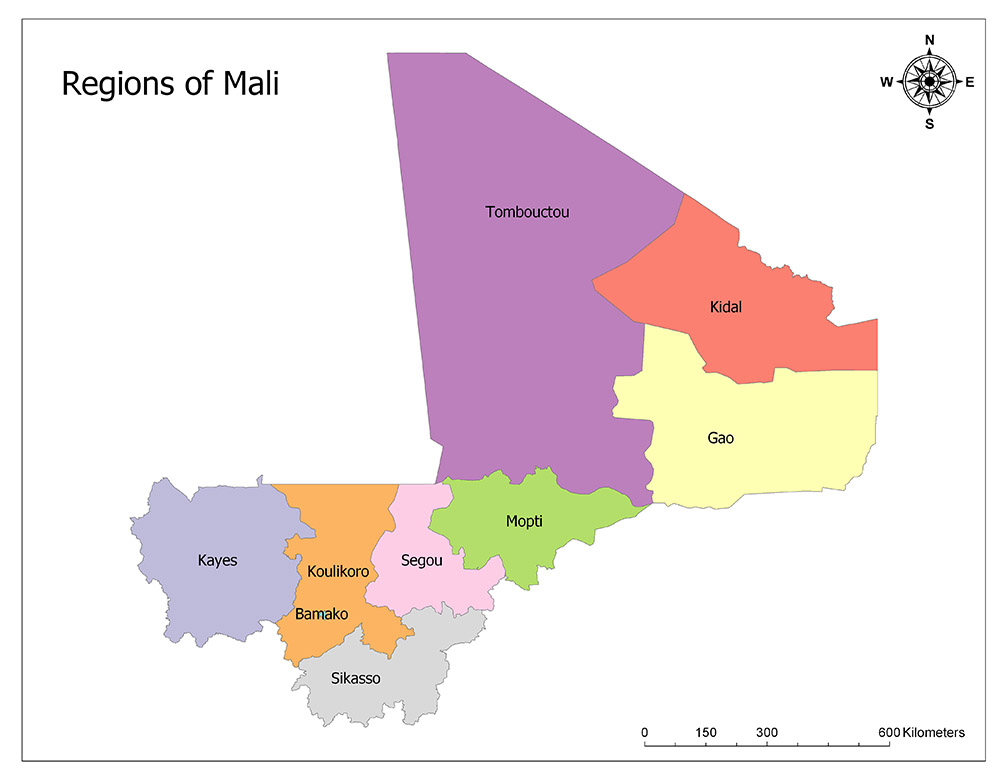Mali’s administrative structure consists of eight regions at the highest level. Equally, there is a capital region, which includes the capital Bamako. All of the regions of Mali has the name of the capital. The regions are divided into second level administrative divisions called 56 Cercles. It is also divided into 703 communes which is the third level administrative division of the regions and capital region.

Nine Regions of Mali
Mali is divided into nine regions, the highest administrative division. Regions of Mali are Kayes, Koulikoro, Bamako, Sikasso, Ségou, Mopti, Tombouctou, Gao and Kidal.
Kayes
Kayes is a region in West Africa, west of Mali. The center is the town of Kayes. Its surface area is 119,813 square kilometers and its population is 1,996,812 according to the 2009 census. The Kayes region is bordered by Mauritania from the north, Senegal from the west, Guinea from the south and Koulikoro from the east. The Region of Kayes is divided into seven cercles.
Koulikoro
The Koulikoro Region is located in the west of Mali. The center is the town of Koulikoro. Its surface area is 90,120 square kilometers and its population is 2,418,305 according to the 2009 census. The Koulikoro region is bordered by Mauritania in the north, Kayes in the west, Guinea and Sikasso in the south and Ségou in the east. The Koulikoro area is divided into seven cercles.
Bamako
Bamako has a population of 2,009,109 according to the 2009 census and is the largest city and capital of Mali. Today it is estimated as the fastest developing African city in the world. It is located on the Niger River and is close to the severe river stream that divides the Upper and Central Niger valleys in the southern tip of the country. Bamako is the nation’s administrative center with a river port near Koulikoro and a large commercial district and conference center.
Sikasso
The Sikasso Region is located in the south of Mali. The center is the town of Sikasso. Its surface area is 71,790 square kilometers and its population is 2,625,919 according to the 2009 census. Sikasso, the capital of the region, is the second largest city in the country and continues to grow rapidly due to people fleeing violence in the south of the Ivory Coast. The Sikasso region is devoted to loving cercles.
Ségou
The Ségou Region is one of the regions south of Mali. The center is Ségou city. Ségou Region (French: Région de Ségou) is one of the regions in the south of Mali. The center is Ségou city. To the west of the Ségou Region is Mopti to the east, Sikasso to the south, Mauritania to the north. The area of 64,821 square kilometers, with 2,336,255 people, is the second most populous district of Mali after the capital. The Ségou region is divided into seven cercles.
Mopti
The Mopti region is located in the central part of Mali. The capital of the region is Mopti. The population of the region is 2,037,330 as of 2009 and has a surface area of 79,017 square kilometers. The Mopti District is bordered by the Tombouctou District in the north, the Ségou District in the southwest, and Burkina Faso in the southeast. The Mopti region is divided into eight cercles.
Tombouctou
The Tombouctou Region is located in the north of Mali. The capital of the region is the city of Tombouctou. The Tombouctou region is the largest of the nine regions of Mali and includes much of the Sahara Desert. The Tombouctou region is divided into five cercles.
Gao
The Gao Region is located in the northeast of Mali. The capital of the region is Gao. The region is limited to Kidal Region from the north, Tombouctou Region from the west and Niger from the south. It shares a small portion of its southern border with Burkina Faso. The Gao region is divided into four cercles.
Kidal
The Kidal Region is located in the northeast of Mali. The capital of the region is the city of Kidal. The region is bordered by Tomboctou Region to the west, Gao Region to the south, Niger to the east and Algeria to the north. Livestock, craftsmanship and trade are among the main trades of Kidal Region. Kidal region is divided into four cercles.